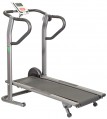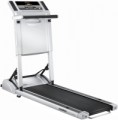Max. user weight
The highest weight of an athlete, at which the treadmill can work indefinitely for a long time (at least during the warranty period) without negative consequences. Most modern models have a "weight category" of the order of 150 kg and even more, which allows them to be used even by people of large build. However, there are exceptions, so this parameter is still worth paying attention to when choosing a treadmill.
It is worth choosing a model by weight with a significant margin — at least 10 kg more than your weight, even if you expect to lose it during training. If, on the contrary, you are going through a comprehensive training course to gain weight, then you should focus on the result you want by the end of the course. Anyway, the "weight category" of the machine must be greater than the weight of the user. Otherwise, the device will work with off-design loads and may break at any time.
If the treadmill is planned to be used for several users, you need to focus on the weight of the heaviest of them.
Load system
—
Mechanical. The simplest type of treadmill. Unlike other types, the belt of such machines does not have devices that ensure its movement (as in electric ones) or, conversely, brake it (as in magnetic ones). The movement is carried out due to the muscular strength of the athlete himself — roughly speaking, you accelerate the belt, pushing off with your feet — and the load changes solely by changing the angle of inclination (see "Adjustable incline"). The main advantage of mechanical treadmills is the simplicity of design and, as a result, low cost. In addition, they usually do not require a connection to the mains — battery power is enough for the installed electronics; Accordingly, you can install such a treadmill almost anywhere. On the other hand, when exercising on mechanical treadmills, you have to apply increased effort, which creates a rather extensive range of restrictions if strong physical exertion is contraindicated for you. People with leg diseases (varicose veins, joint problems, consequences of injuries) should be especially careful. Before choosing a treadmill, they should consult a doctor.
—
Magnetic. As in mechanical treadmills (see above), the movement in magnetic models is provided by the efforts of the athlete himself. Their main difference is the permanent magnet installed in the design, designed to regulate the load. It allows you to do without changing the angle of inclinat
...ion, the machines are less bulky and lighter. In addition, the work of magnetic treadmills is much smoother than that of conventional mechanical ones, and they usually do not require a connection to the mains. On the other hand, magnetic models also create an increased load on the legs and may not be suitable for people with certain diseases. They cost more than mechanical ones.
— Electric. The most advanced version of modern treadmills. The belt is driven by an electric motor, which allows you to change the load both by changing the angle of inclination and by changing the speed of the electric motor. Due to this, almost any resistance of the belt can be set. Thanks to all this, machines of this type are suitable both for professional athletes and for people who are contraindicated in heavy loads on their legs (although in the latter case, it is still worth starting training only after consulting a doctor). In addition, the functionality of electric tracks is much wider; it is in this type that special training programs can be applied (see below). Among the disadvantages are the high price and dependence on power sources — electric treadmills require a connection to the mains, which accordingly limits the possibilities for their placement.Min. running speed
The slowest speed at which the treadmill belt can move. This parameter is indicated only for
electric models (see "Load system"), as in other types, it depends solely on the user himself.
The ability to operate the belt at a low speed is important if strong loads are contraindicated — for example, during the rehabilitation period after injuries. In many modern models, this figure is only 1 km/h (even though the average walking speed of a healthy person is about 5 km/h). Thus, they can be used even with serious injuries, when normal walking is very difficult.
Max. running speed
The highest speed at which the treadmill belt can move. This parameter is indicated only for models of the electric type (see above). For mechanical and magnetic ones, it depends solely on the capabilities of the athlete himself, and it is impossible to accurately indicate the maximum speed in the characteristics of such machines.
The higher the maximum speed the greater the load can be given to the athlete and the better the treadmill is suitable for intensive training. However, for home models, a speed of 15 – 16 km/h is considered quite sufficient; "faster" machines usually belong to the advanced class and are designed for professional athletes.
Note, that for everyday use it does not always make sense to chase a high maximum speed. If your level of physical fitness is not high or if high loads are undesirable, a speed of 10 – 12 km/h may well be enough.
Motor power
Power of the motor installed in the electric treadmill (see "Load system"). This parameter is directly related, first of all, to the smoothness of the belt movement and the maximum speed (see above) — the more powerful the motor, the more uniform the movement of the belt will be and the faster it can move. Also, motor power determines the resistance to high loads: with an equal weight category (see "User weight"),
a more powerful model is better suited for people with large body weight, especially at high speeds.
In general, most recreational treadmills have motors between 1.5 and 2.5 hp; more powerful options usually belong to the professional class.
It is worth noting that above we were talking about the constant power of the motor — that is, the power with which it can work for a long time without being subjected to overloads. In some models of treadmills, the so-called peak power — the power that the motor can develop for a short time, for a few seconds. It is higher, but long-term operation at such a load is fraught with the failure of the device. Therefore, before buying, it is worthwhile to clarify, if possible, what power is implied in the specs — nominal or peak; this is especially true for high-power models.
Incline adjustment
Possibility to change the angle of inclination of the treadmill. Due to this, in mechanical and electrical models (see "Load system"), the load is regulated; in the first case, this is generally the only option for changing the load, and in the second, the slope of the belt allows you to simulate movement uphill (and in some models, vice versa, from the mountain).
The angle of inclination is usually adjusted manually by setting the belt to a certain level of a special stop. However, there are also automatic models where a separate drive does this, and the user only needs to give a command from the control panel. The second option is more convenient but significantly more expensive.
Cushioning system
The cushioning system softens the shock felt when running on the treadmill and thus reduces stress on the bones and joints. Roughly speaking, due to this system, the belt “springs” under your feet, and the run turns out to be softer. This feature can be useful to any user, but it will be especially useful for those who are just starting, as well as for people with a large body weight.
Training programs
The number of
training programs provided for in the design of the simulator. This is not about load levels, but about automatic modes of operation, during which the belt can change the speed of movement, signal the beginning and end of a workout, etc. For details on the number of programs, see Programs and information.
Running belt size (LxW)
Under the dimensions of the belt in the specs of treadmills, they usually mean the dimensions of the working area — that is, the running deck within which the user's feet stay during training. Several points determine the optimal length and width of the belt.
The long treadmill length ensures safety — less likely to seriously stumble and fall out of rhythm. On the other hand, a long belt requires a more powerful motor, and the dimensions of the treadmills increase accordingly. With all this in mind, it is believed that the optimal length for home use is 120 – 130 cm; longer belts are designed for use in fitness centres and professional training.
Both safety and comfort when using the treadmill also depend on the width of the belt. This parameter is especially important for people of large build — on a narrow canvas, they can be “cramped”. On the other hand, as in the case of length, a large width means a large size of the treadmill itself. In general, entry-level models have a belt up to 40 cm, in more advanced treadmills there are options for 45 cm, and for professional use, this figure can reach 50 cm.
When choosing a treadmill according to the size of the belt, it is best not only to take into account all of the above, but also to try out the option that interests you before making a purchase. After all, a lot depends on personal characteristics and preferences, and a seemingly suitable treadmill may be small — or vice versa, a more...compact and inexpensive option is quite suitable.

